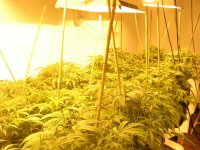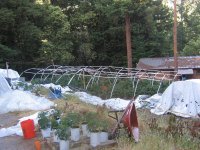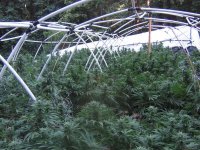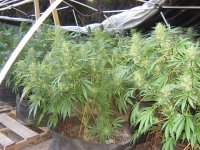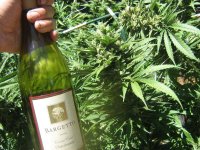-
Happy Birthday ICMag! Been 20 years since Gypsy Nirvana created the forum! We are celebrating with a 4/20 Giveaway and by launching a new Patreon tier called "420club". You can read more here.
-
Important notice: ICMag's T.O.U. has been updated. Please review it here. For your convenience, it is also available in the main forum menu, under 'Quick Links"!
You are using an out of date browser. It may not display this or other websites correctly.
You should upgrade or use an alternative browser.
You should upgrade or use an alternative browser.
2012 Light Deprivation (for everybody)
- Thread starter ghettochild
- Start date
DeliciousBuds
Member
DeliciousBuds
Member
DeliciousBuds
Member
DeliciousBuds
Member
I prevent humidity buildup in my light depo grow by covering the hoop house at approx. 6pm and then pulling the cover back off after it gets dark-around 10pm. In my experience, the short 4 hour period that they are blacked out is not enough time for the humidity to reach critical levels, even during late flowering.
DB
DB
beautiful pics! man your are lucky to live somewhere so stunning,,
what are all the purply nugs above?? looks like bubba but bigger
great work

what are all the purply nugs above?? looks like bubba but bigger

great work

DeliciousBuds
Member
Yes, Southern Oregon has some beautiful country, my friend. The strain in those pictures is a cross between WiIIiams Wonder and Purple Haze. It was a really easy strain to grow. The medicinal effect was it's best quality, which I'd describe as an enjoyable, functional, uplifting and euphoric, Sativa-like high, which I recommended that my patients should use in the morning and afternoon. It's draw back was bag appeal, poor bud vs. leaf ratio, and poor bud density. I said it "was" fun to grow, because I removed it from my line up. Apparently, it didn't respond very well to being big-leafed. It would invariably cause that strain to hermi, which to me, outweighed its usefulness.
: )
: )
ghettochild
Active member
ghettochild
Active member
ghettochild
Active member
ghettochild
Active member
Looking good!
this thread featured below!
http://cannabisnowmagazine.com/grow...vation-laws-are-environmentally-unsustainable
There has been a lot of press recently about the newly legalized states of Colorado and Washington. When cultivation is discussed, we refer to massive indoor grows that are either up and running or in the process of being built. These giant power hungry behemoths are often 100 lights or more.
Since the power needed to produce one pound of cannabis takes 200 pounds of coal, the environmental impacts of such mega grows are obvious, and that’s just the requirement for the lights—air conditioning and or heating, pumps and fans add to the growing mountain of coal or ocean of oil needed to produce what most consider a green product. The answer in most parts of the country is obvious. Use the sun. It’s free.
Sun grown cannabis has always accounted for the majority of the export market in California. People from coast to coast enjoy the bounty of the abundant yearly harvest. With the advent of light deprivation technology in the last five years, there are now actually three harvests, starting in July and running through the traditional October haul.
Both Colorado and Washington allow for at least greenhouse production of cannabis. Colorado limits the allowable area to one small part of the state and Washington’s best outdoor climate is in the Eastern section, which unfortunately has an extremely unfriendly U.S. District Attorney, making large-scale greenhouse cultivation difficult. Even with this being the case, we as conscious planetary citizens should be doing all we can to promote greener growing practices.
As more states legalize, it is important to promote greener practices. Solar and wind, while initially expensive, can help ease some of the burden, more importantly though continuing to promote Sun Grown cannabis as not only the greenest way to grow but also the least expensive.
Compared to the rising costs of electricity, the price of the sun is a constant.
There is no reason most states can’t grow in greenhouses. Even Alaska, home of the legendary strain Matanuska Thunderfuck, has a short but serviceable window to grow using the sun. That epic indica was actually first grown in rudimentary greenhouses in Alaska’s relatively temperate Matanuska valley. Montana is also a medical state and they were growing in greenhouses until the federal government came calling, proving that a cold climate and short growing season can still produce quality flowers.
Sun Grown cannabis contains many more cannabinoids than its lamp grown counterparts. The quality has come a long way in the last decade with the advent of full-sun grows. With the increase in light deprivation technology it can also look exactly like indoor, traditionally one of the reasons people have preferred the latter. The THC percentages can also exceed that of indoor in the same strain, if grown with skill.
Many people outside of California consume cannabis that was grown in a greenhouse that they have purchased as indoor. The quality can truly be that good. As more states legalize, those with a stake in the future, and I believe that is all of us, should be demanding that the cannabis they consume has been grown with as little ecological impact as possible. The only way to ensure that is by using the sun.
By Rick Pfrommer, Director of Education at Harborside Health Center
http://cannabisnowmagazine.com/grow...vation-laws-are-environmentally-unsustainable
There has been a lot of press recently about the newly legalized states of Colorado and Washington. When cultivation is discussed, we refer to massive indoor grows that are either up and running or in the process of being built. These giant power hungry behemoths are often 100 lights or more.
Since the power needed to produce one pound of cannabis takes 200 pounds of coal, the environmental impacts of such mega grows are obvious, and that’s just the requirement for the lights—air conditioning and or heating, pumps and fans add to the growing mountain of coal or ocean of oil needed to produce what most consider a green product. The answer in most parts of the country is obvious. Use the sun. It’s free.
Sun grown cannabis has always accounted for the majority of the export market in California. People from coast to coast enjoy the bounty of the abundant yearly harvest. With the advent of light deprivation technology in the last five years, there are now actually three harvests, starting in July and running through the traditional October haul.
Both Colorado and Washington allow for at least greenhouse production of cannabis. Colorado limits the allowable area to one small part of the state and Washington’s best outdoor climate is in the Eastern section, which unfortunately has an extremely unfriendly U.S. District Attorney, making large-scale greenhouse cultivation difficult. Even with this being the case, we as conscious planetary citizens should be doing all we can to promote greener growing practices.
As more states legalize, it is important to promote greener practices. Solar and wind, while initially expensive, can help ease some of the burden, more importantly though continuing to promote Sun Grown cannabis as not only the greenest way to grow but also the least expensive.
Compared to the rising costs of electricity, the price of the sun is a constant.
There is no reason most states can’t grow in greenhouses. Even Alaska, home of the legendary strain Matanuska Thunderfuck, has a short but serviceable window to grow using the sun. That epic indica was actually first grown in rudimentary greenhouses in Alaska’s relatively temperate Matanuska valley. Montana is also a medical state and they were growing in greenhouses until the federal government came calling, proving that a cold climate and short growing season can still produce quality flowers.
Sun Grown cannabis contains many more cannabinoids than its lamp grown counterparts. The quality has come a long way in the last decade with the advent of full-sun grows. With the increase in light deprivation technology it can also look exactly like indoor, traditionally one of the reasons people have preferred the latter. The THC percentages can also exceed that of indoor in the same strain, if grown with skill.
Many people outside of California consume cannabis that was grown in a greenhouse that they have purchased as indoor. The quality can truly be that good. As more states legalize, those with a stake in the future, and I believe that is all of us, should be demanding that the cannabis they consume has been grown with as little ecological impact as possible. The only way to ensure that is by using the sun.
By Rick Pfrommer, Director of Education at Harborside Health Center
Z
z-ro
So what does bumping this two year old thread with harborsides worthless opinion have to do with anything? Like we need those loooosers telling us anything about cannabis, especially since they were trying to monopolize the market with legal mega grows indoors not long ago. Biggest chumps in the industry hands down.
Flankenstein
New member
Flankenstein
New member
Flankenstein
New member
to elaborate a bit on the grow above-
got clones 4/1(green crack) vegged for one month inside under 1000w HPS (any normal veg light will do, we just had a flower room to use). started the cuttings in 1 gals, 10 days lter to the 3 gals, and we began bringing them outside and hardening off in May.
Once the hoop houses were set, we transplanted into anywhere from 30-50 gallon smart pots (some in ground, which did the best too obviously). mostly Happy frog and perilite. Than we strung work lights to keep the plants awake for about 15 more days, having the lights turn on around sunset to midnight or so. After that the lights dont come on, and we let them naturally stretch into flower.
At first signs of flower, we than began the black boxing at 7am-7pm. Dont be lazy and start jumpng your times around i.e. tarping at 6:30pm to go to a bbq, than sleeping in and untarping late, LIGHT DEPS ARE SENSITIVE TO STRESS. try and be as prompt as possible, the consistant amount of darkness is important.
use dehumidifiers and/or pull your covers off after sunset during the latter part of flower. be ready for spuratic rains and mold inducing conditions (pick a strong strain). spray with neem and serenade.
i love light deps theye so much fun and rewarding to see flowers developing everytime you lift the tarp. It is definitley not for the lazy so be ready to work for that extra bit of honey. Post any feedback or Q's ill try and check back in. prop 215 compliant ~NAMASTE~
got clones 4/1(green crack) vegged for one month inside under 1000w HPS (any normal veg light will do, we just had a flower room to use). started the cuttings in 1 gals, 10 days lter to the 3 gals, and we began bringing them outside and hardening off in May.
Once the hoop houses were set, we transplanted into anywhere from 30-50 gallon smart pots (some in ground, which did the best too obviously). mostly Happy frog and perilite. Than we strung work lights to keep the plants awake for about 15 more days, having the lights turn on around sunset to midnight or so. After that the lights dont come on, and we let them naturally stretch into flower.
At first signs of flower, we than began the black boxing at 7am-7pm. Dont be lazy and start jumpng your times around i.e. tarping at 6:30pm to go to a bbq, than sleeping in and untarping late, LIGHT DEPS ARE SENSITIVE TO STRESS. try and be as prompt as possible, the consistant amount of darkness is important.
use dehumidifiers and/or pull your covers off after sunset during the latter part of flower. be ready for spuratic rains and mold inducing conditions (pick a strong strain). spray with neem and serenade.
i love light deps theye so much fun and rewarding to see flowers developing everytime you lift the tarp. It is definitley not for the lazy so be ready to work for that extra bit of honey. Post any feedback or Q's ill try and check back in. prop 215 compliant ~NAMASTE~
Great thread. I’m planning a little action like this myself!!





















